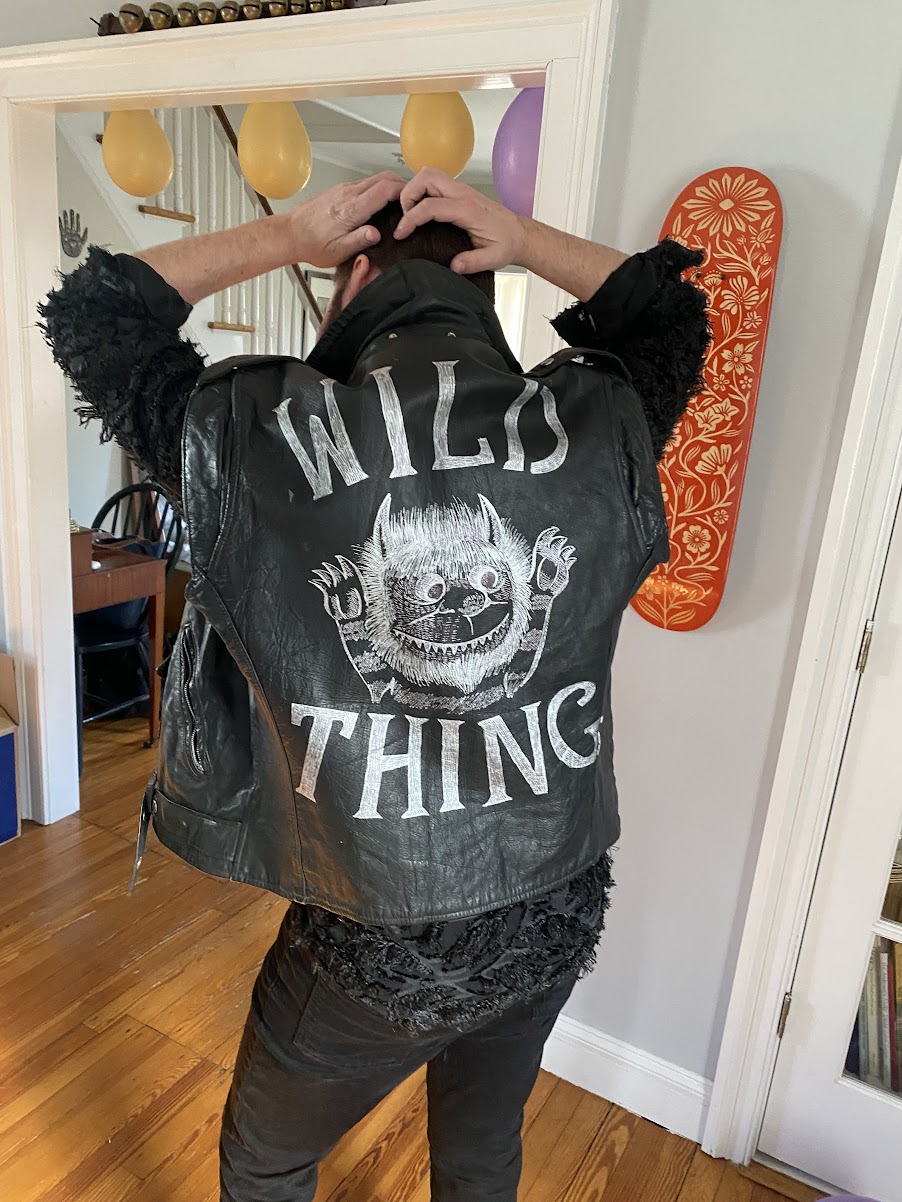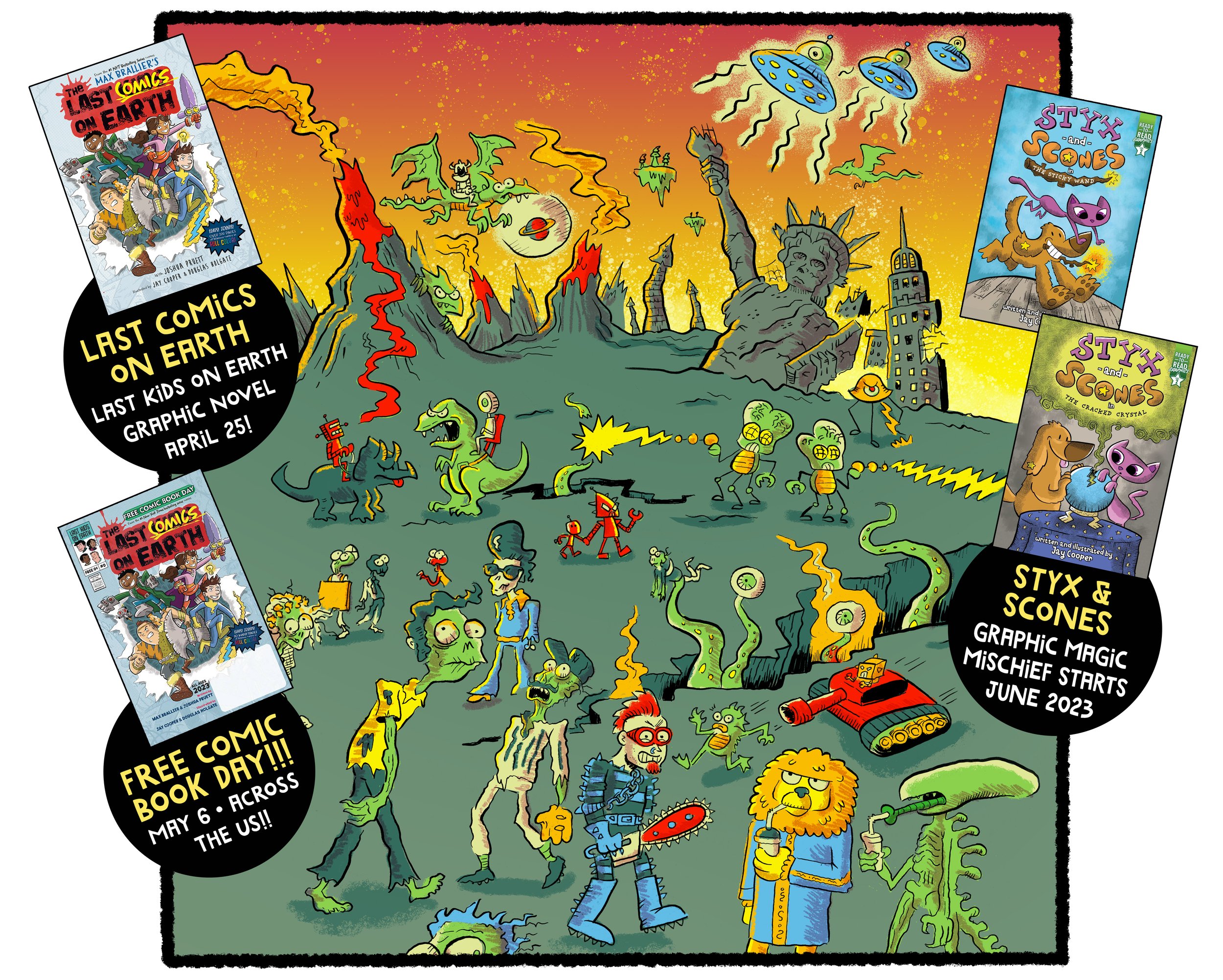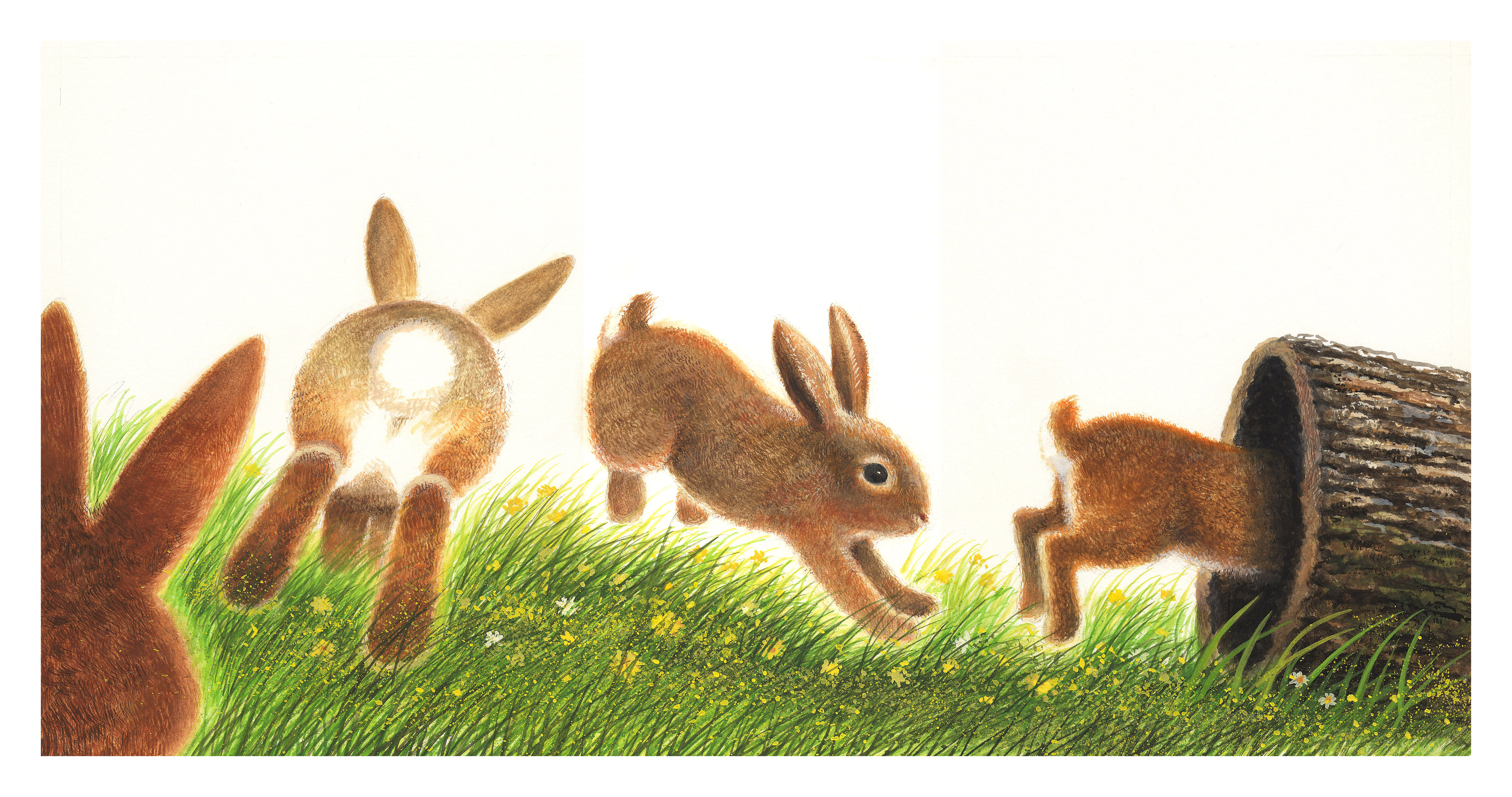–
Jay Cooper is just another one of those young, vibrant, obnoxiously talented people that I’ve learned to despise with every fiber of my being.
Wait, did I say that out loud?
I mean: Jay is a great guy, full of kindness and warmth and vast enthusiasms. I take pleasure in watching his career lift off into the stratosphere. Terrific things are happening. And a big part of Jay’s success — besides the fact that the man works damn hard — is that he has a gift for connecting with young readers. The sensibilities align. It’s a tired cliche to say that it’s because Jay’s a kid himself. This is a grown actual man with a job and a wife and children and a house. I’m pretty sure he pays federal income tax. But you get the sense that Jay still gets jelly smeared on the sofa cushions and sometimes forgets to flush the toilet and lines up hours in advance for Marvel movies and roots like a kid, with pure innocent glee, for his/our beloved New York Mets. Every pitch, every game. He’s that kind of guy.
Let’s say hello.
–
1) Welcome to James Preller Dot Com, Jay Cooper. Grab a milk crate and have a seat. I sometimes puzzle over the question: Why do I like Jay Cooper so freaking much? And I’ve settled on this: It’s because you have so many passions and enthusiasms. You look at this crazy, mixed-up world of ours and respond with optimism and good cheer. So Jay, without giving this any deep thought — since I know that’s difficult for most illustrators — please name 10 random things that you are loving right now. You’ve got 30 seconds . . .
–
This is starting out like a game show, and I’M HERE FOR IT. (Rubs hands…sets timer… GO!)
- Only Murders in the Building
- The Teenage Mutant Ninja Turtles movie: stylistic, cool, and crunchy
- Kimberly Akimbo on Broadway
- Cross-hatching
- School visits (Man, I missed getting in front of a crowd over the last couple years.)
- The Maurice Sendak-themed vintage leather jacket I just painted for a gala
- Wednesday (The Addams Family themed show… not the day of the week.)
- Old school comic books
- Svengoolie monster movies on Saturday night
- Running in the morning (I need to do more)
DING!
–
Hold on. What jacket? Show us, please.
–
–
2)Ah, thanks. It reminds me a little of Springsteen’s “Born in the USA” album photo — but for book nerds. Question: Who or what or when were the big influences on your art work? What feeds it?
Wow, that is such a gigantic question.
Sorry!
I’d say my primary source of inspiration since the beginning has been Graphic with a capital “G”: It started with Sendak and Seuss at 4, web-slung straight into Marvel comics at age 6 via Stan the Man, John Buscema, Chris Claremont, John Byrne, George Perez then went SPLOINK into Mad Magazine and the humorists around age 9 or 10 with Sergio Aragones’s Groo, Spy Vs. Spy, Don Martin… And afterwards, of course, Edward Gorey, Charles Addams and Neil Gaiman filled in the grave in my teens. And this is of course the tip of the iceberg… so very, very many more have inspired me over the years.
–
–
3) It’s hard to answer this question, but it’s something that many kids find mysterious and otherworldly, so please give it a try: Where do your ideas come from? I mean, here you are, bursting with books, making it all look easy. Perhaps you could answer in terms of this new series, Styx and Scones.
–
The short, cryptic answer is: ideas come from everywhere, anywhere and nowhere.
Now for the long answer: the germ of an idea is still just the germ—you have to give it soil and space to grow into something special and strong. Styx and Scones is a great example: that dog and cat have been in my head for 9 years now and are finally becoming a book this June. Styx was originally created for an unpublished board book, Ciao Meow. She rode a Vespa and wore Penelope Pitstop helmet. For my first school visit presentation, I dropped the Vespa, reimagined her as “Words” and teamed her up with a dog “Pictures” to demonstrate to children how pictures and words are often not expected to  interact in literature. My agent suggested using them for a book, but some essential element was missing. Two years ago, I drew a witchy cat flying and out-of-control broom with an assortment of other witchy pets for an agency calendar, and I knew that was the world this pair should live in. Once I added some magic, a couple of old witches and mashed up the world of the Smurfs with some Gorey cross-hatching goodness it all made sense: a pink witchy cat named Styx, and her best friend, a witchy dog named Scones. That’s a roundabout way to say that inspiration is quite often a long, multi-step process. Sometimes you gotta stir the risotto a long time.
interact in literature. My agent suggested using them for a book, but some essential element was missing. Two years ago, I drew a witchy cat flying and out-of-control broom with an assortment of other witchy pets for an agency calendar, and I knew that was the world this pair should live in. Once I added some magic, a couple of old witches and mashed up the world of the Smurfs with some Gorey cross-hatching goodness it all made sense: a pink witchy cat named Styx, and her best friend, a witchy dog named Scones. That’s a roundabout way to say that inspiration is quite often a long, multi-step process. Sometimes you gotta stir the risotto a long time.
–
Not really a question: Who wins more games this season for the New York Mets, Max Scherzer or Justin Verlander? (We should start a message thread with children’s book people who are also Mets fans. Paging Alan Katz! I think that’s everyone.)
Scherzer. But only because he’s got two different colored eyes, and he’s such a character. I’m always drawn to characters. I still miss Justin Turner as a Met. He wasn’t great on the team per se, but I loved that red hair and beard. I used to shout out a John Sciezka title whenever he came to bat: “Viking It and Liking It!”
Wait. Did I mention John Sciezka earlier as an influence? Lane Smith? Those guys were BIG inspirations right after college.
–
–
4) Do you ever consider writing a book with more text, more serious topics? How are you going to surprise us in the future? Any ideas on the back burner?
–
Oooo! GOOD QUESTION, Jimmy! I do have an idea for a middle grade novel. But (see above) it’s still only a germ. So not sure how long it needs to cook. And I think it needs a co-writer. I’m big on teams. My favorite books are collaborations. (Good Omens by Neil Gaiman and Terry Pratchett is my favorite book going on thirty years!)
–
–
5) I remember first meeting you at the Warwick Children’s Book Festival. You came up to me and said hello. A young guy with a fabulous waxed mustache (at the time), relatively new to the business. I’ve been rooting for you ever since. I see that you’ve started to do some school visits. How has that experience gone for you, walking through those doors, speaking to all those kids? They must love you. Do you have a message or a main idea that you are trying to get across?
–
Mister, I’d never have talked to you if you didn’t just radiate goodness. I knew literally no one. I think that was my second festival? (I’m still a bit shy around other creators.) Kids, however, are a different animal entirely. I LOVE getting in front of them and just cutting loose: funny stories, drawing exercises… I think I sweat off a few pounds each time I present.
And I do have a message. A few, actually.
–
The first is that reading what you love makes you a strong reader. Don’t listen to any noise about what you read being too goofy, silly, violent, poopy, whatever. I’m the person I am because I fell head over heels for comic books and humor magazines. Comics boosted my vocabulary, they taught me grammar, and narrative structure. Positively reinforced reading leads to more. I’m living proof that Spider-Man leads to loving Shakespeare, and Mad Magazine to Maya Angelou.
The second is it took three failed books for one to succeed. That process was necessary. And learning from mistakes and not giving up is key (that’s one for all the aspiring writers/illustrators out there!)
The third is just built-in to the presentation. Growing up in Dover, Delaware in the 70s and 80s, I never met a person who worked as a creative professional (aside from my art teachers, who I adored). Books felt like they were handed down from the gods atop Mt. Olympus. When I moved to NYC and met people who were creative for a living my whole perception of the world shifted. The impossible was suddenly tangible and quite possible, if I was determined to put the work in.
–
–
I feel like I should ask you a question, Jimmy.
Oh, wow, yeah. Normally I’d be happy to loan you money, Jay, but you see —
No, I’m not asking for money.
Okay, fire away.
I’m seeing some awesome school visits you’ve been on recently. You radiate calm, cool and collected. I am an energetic mess. Any tips how I can pace myself? Second question: how do you balance the content to make it more about the students and less about yourself? That’s one thing I’m trying to tweak.
Okay, briefly: In terms of pacing, I used to ask that, too. How do teachers do it? This is exhausting! I quickly realized that I’m not a jugular, I’m not a magician. So I’ve tried to calm down and just be authentic, honest, and respectful. I’m not here to razzle-dazzle anyone. Sure, we try to laugh, too. And I work hard. But ultimately, you can only be yourself.
And regarding the second part, it’s a good sign that you even ask that question. If you love the kids, and I know you do, then it will flow out of you naturally and everyone in the audience will see it, and feel it, and know in their hearts that you are there for them. We’re just vehicles given the amazing opportunity to try to inspire readers, writers, compassionate thinkers. It is 100% for them and about them. Far bigger than you or me.
–
–

 JAMES PRELLER is the author of a wide range of books, including the popular Jigsaw Jones series. He has also written middle-grade and YA novels: Bystander, Upstander, Blood Mountain, The Courage Test, The Fall, and more. Look for the first book in his strange & mysterious EXIT 13 series for readers ages 8-12: The Whispering Pines. Book 2 comes out in August — so save up!
JAMES PRELLER is the author of a wide range of books, including the popular Jigsaw Jones series. He has also written middle-grade and YA novels: Bystander, Upstander, Blood Mountain, The Courage Test, The Fall, and more. Look for the first book in his strange & mysterious EXIT 13 series for readers ages 8-12: The Whispering Pines. Book 2 comes out in August — so save up!
























